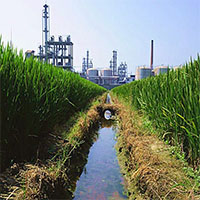
Quantifying Mercury of Rice and Its Impact on Food Security in China
MIT study to investigate exposure pathways and mitigation opportunities
MIT Abdul Latif Jameel World Water and Food Security Lab
Often, food security is thought of as a question of supplying and distributing sufficient and nutritious food for the global population. How can we produce enough food to get to enough people? But what happens when the food to be produced and distributed is contaminated by toxic pollutants? And what about when that food supply is among one of the largest in the world? Noelle Selin, the Esther and Harold E. Edgerton Career Development Associate Professor in the Institute for Data, Systems, and Society and the Department of Earth, Atmospheric and Planetary Sciences, and Valerie Karplus, Assistant Professor of Global Economics and Management in the Sloan School of Management, are investigating this question in the context of mercury contamination of food crops.
Selin and Karplus have directed their focus towards China, where increasing industrial activities and the resulting large-scale environmental contamination of mercury has become a looming food security threat. As the largest producer and consumer of rice -- a staple food for nearly half of the world -- the ramifications of this phenomenon cannot be understated. Mercury in the environment and its interaction with rice remains a complex food security issue, in large part, due to the complexity of mercury sources and biogeochemical processes that govern mercury accumulation in rice grains. While mercury contamination of fish is fairly well known, rice represents an underappreciated yet potentially significant source of mercury exposure in vulnerable populations.
As Selin and Karplus explain, mercury in the form of monomethylmercury (MMHg) is toxic and bioaccumulative, and can cause neurotoxic impacts upon exposure. Mercury is released from coal-fired electricity generation and other industrial activities, and travels regionally and globally through the atmosphere before it enters ecosystems. MMHg, an organic form of mercury, is then produced in the environment – and this process can occur in flooded rice paddies. Growing plants take up the mercury, and MMHg then accumulates in rice.
Recent work in Selin’s group examined how future development could increase the amount of mercury depositing to ecosystems in China, and how policies such as the recent global treaty on mercury (the Minamata Convention) might affect this source. The need to understand the sources and nature of how mercury is transformed to MMHg and accumulated in food supplies will thus become even more urgent as other emerging markets follow China's lead on the path to industrialization.
The goal of Selin and Karplus's J-WAFS-funded research is multi-tiered: they will identify the largest sources of MMHg pollution, better understand the processes by which MMHg contamination occurs, and project trends for this phenomenon into the future. They will do this by linking environmental modeling with economic cost analyses through the utilization of cutting-edge tools, including the GEOS-Chem atmospheric chemistry transport model for mercury, with the China-Regional Energy Model (C-REM), a global energy-economic model with provincial-level detail in China.
The findings of this work will be complemented by another collaborative project led by Karplus and Selin that is seeking to better understand the relationship between Chinese coal use and toxic air pollution throughout Asia. Sponsored by the MIT Environmental Solutions Initiative (ESI), this research is using data analysis and integrated modeling, which their team of economists, engineers, and atmospheric chemists hope will identify the most effective approaches to tackle the air quality impacts of coal burning.
Commenting on the potential impact of their research, Prof. Selin noted that, “Through this work, we will gain a more complete picture of the sources of mercury to the Chinese environment, and potential pathways by which people are exposed. We will then use this information to inform policies designed to mitigate risks from mercury exposure.”

